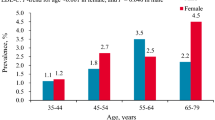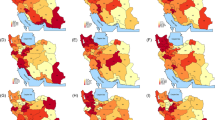Abstract
The lipoprotein lipase (LPL) gene encodes a rate-limiting enzyme protein that has a key role in the hydrolysis of triglycerides. Hypertriglyceridemia, one widely prevalent syndrome of LPL deficiency and dysfunction, may be a risk factor in the development of dyslipidemia, type II diabetes (T2D), essential hypertension (EH), coronary heart disease (CHD) and Alzheimer's disease (AD). Findings from earlier studies indicate that LPL may have a role in the pathology of these diseases and therefore is a common or shared biological basis for these common complex diseases. To examine this hypothesis, we reviewed articles on the molecular structure, expression and function of the LPL gene, and its potential role in the etiology of diseases. Evidence from these studies indicate that LPL dysfunction is involved in dyslipidemia, T2D, EH, CHD and AD; and support the hypothesis that there is a common or shared biological basis for these common complex diseases.
Similar content being viewed by others
Log in or create a free account to read this content
Gain free access to this article, as well as selected content from this journal and more on nature.com
or
References
Havel RJ, Gordon Jr RS : Idiopathic hyperlipemia: metabolic studies in an affected family. J Clin Invest 1960; 39: 1777–1790.
Henderson HE, Ma Y, Hassan MF et al: Amino acid substitution (Ile194—Thr) in exon 5 of the lipoprotein lipase gene causes lipoprotein lipase deficiency in three unrelated probands. Support for a multicentric origin. J Clin Invest 1991; 87: 2005–2011.
Liu A, Lee L, Zhan S et al: The S447X polymorphism of the lipoprotein lipase gene is associated with lipoprotein lipid and blood pressure levels in Chinese patients with essential hypertension. J Hypertens 2004; 22: 1503–1509.
Creyer A : Tissue lipoprotein lipase activity its action in the lipoprotein metabolism. Int J Biochem 1981; 13: 525–541.
Wang CS, Hartsuck J, McConathy WJ : Structure and functional properties of lipoprotein lipase. Biochim Biophys Acta 1992; 1123: 1–17.
Seip RL, Semenkovich CF : Skeletal muscle lipoprotein lipase: molecular regulation and physiological effects in relation to exercise. Exerc Sport Sci Rev 1998; 26: 191–218.
Merkel M, Kako Y, Radner H et al: Catalytically inactive lipoprotein lipase expression in muscle of transgenic mice increase very low density lipoprotein uptake: direct evidence that lipoprotein lipase bridging occurs in vivo. Proc Natl Acad Sci USA 1998; 95: 13841–13846.
Merkel M, Heeren J, Dudeck W et al: Inactive lipoprotein lipase (LPL) alone increases selective cholesterol ester uptake in vivo, whereas in the presence of active LPL it also increases triglyceride hydrolysis and whole particle lipoprotein uptake. J Biol Chem 2002; 277: 7405–7411.
Mead JR, Ramji DP : The pivotal role of lipoprotein lipase in atherosclerosis. Cardiovasc Res 2002; 55: 261–269.
Mamputu JC, Desfaits AC, Renier G : Lipoprotein lipase enhances human monocyte adhesion to aortic endothelial cells. J Lipid Res 1997; 38: 1722–1729.
Doolittle MH, Ben-Zeev O, Elovson J et al: The response of lipoprotein lipase to feeding and fasting. Evidence for posttranslational regulation. J Biol Chem 1990; 265: 4570–4577.
Lithell H, Boberg J, Hellsing K et al: Lipoprotein lipase activity in human skeletal muscle and adipose tissue in the fasting and the fed states. Atherosclerosis 1978; 30: 89–94.
Wittrup HH, Tybjærg-Hansen A, Nordestgaard BG : Lipoprotein lipase mutations, plasma lipids and lipoproteins, and risk of ischemic heart disease: a meta-analysis. Circulation 1999; 99: 2901–2907.
Feoli-Fonseca JC, Levy E, Godard M et al: Familial lipoprotein lipase deficiency in infancy: clinical, biochemical, and molecular study. J Pediatr 1998; 133: 417–423.
Jemaa R, Fumeron F, Poirier O et al: Lipoprotein lipase gene polymorphisms: associations with myocardial infarction and lipoprotein levels, the ECTIM study. J Lipid Res 1995; 36: 2141–2146.
Groenemeijer BE, Hallman MD, Reymer PW et al: Genetic variant showing a positive interaction with β-blocking agents with a beneficial influence on lipoprotein lipase activity, HDL cholesterol, and triglyceride levels in coronary artery disease patients: the Ser447-stop substitution in the lipoprotein lipase gene. Circulation 1997; 95: 2628–2635.
King H, Aubert RE, Herman WH : Global burden of diabetes, 1995–2025: prevalence, numerical estimates, and projections. Diabetes Care 1998; 21: 1414–1431.
Yamada Y, Matsuo H, Warita S et al: Prediction of genetic risk for dyslipidemia. Genomics 2007; 90: 551–558.
Hu Y, Ren Y, Luo RZ et al: Novel mutation of the lipoprotein lipase gene associated with hypertriglyceridemia in members of type 2 diabetes pedigrees. J Lipid Res 2007; 48: 1681–1688.
Yang W, Huang J, Yao C et al: Linkage and linkage disequilibrium analysis of the lipoprotein lipase gene with lipid profiles in Chinese hypertensive families. Clin Sci (Lond) 2005; 108: 137–142.
Ross CJ, Twisk J, Meulenberg JM et al: Long-term correction of murine lipoprotein lipase deficiency with AAV1-mediated gene transfer of the naturally occurring LPL (S447X) beneficial mutation. Hum Gene Ther 2004; 15: 909–919.
Kodera M, Hayakawa I, Komura K et al: Anti-lipoprotein lipase antibody in systemic sclerosis: association with elevated serum triglyceride concentrations. J Rheumatol 2005; 32: 629–636.
Hölzl B, Iglseder B, Sandhofer A et al: Insulin sensitivity is impaired in heterozygous carriers of lipoprotein lipase deficiency. Diabetologia 2002; 45: 378–384.
Hu Y, Liu W, Huang R, Zhang X : A systematic review and meta-analysis of the relationship between lipoprotein lipase Asn291Ser variant and diseases. J Lipid Res 2006; 47: 1908–1914.
Goodarzi MO, Guo X, Taylor KD et al: Lipoprotein lipase is a gene for insulin resistance in Mexican Americans. Diabetes 2004; 53: 214–220.
Koike T, Liang J, Wang X et al: Overexpression of lipoprotein lipase in transgenic watanabe heritable hyperlipidemic rabbits improves hyperlipidemia and obesity. J Biol Chem 2004; 279: 7521–7529.
Ferreira LD, Pulawa LK, Jensen DR et al: Overexpressing human lipoprotein lipase in mouse skeletal muscle is associated with insulin resistance. Diabetes 2001; 50: 1064–1068.
Pulawa LK, Eckel RH : Overexpression of muscle lipoprotein lipase and insulin sensitivity. Curr Opin Clin Nutr Metab Care 2002; 5: 569–574.
Cruz WS, Kwon G, Marshall CA et al: Glucose and insulin stimulate heparin-releasable lipoprotein lipase activity in mouse islets and INS-1 cells. A potential link between insulin resistance and beta-cell dysfunction. J Biol Chem 2001; 276: 12162–12168.
Jeunemaitre X, Soubrier F, Kotelevtsev YV et al: Molecular basis of human hypertension: role of angiotensinogen. Cell 1992; 71: 169–180.
Yang W, Huang J, Ge D et al: Lipoprotein lipase gene is in linkage with blood pressure phenotypes in Chinese pedigrees. Hum Genet 2004; 115: 8–12.
Yang WJ, Huang JF, Yao CL et al: Evidence for linkage and association of the markers near the LPL gene with hypertension in Chinese families. J Med Genet 2003; 40: e57.
Tu X, Tu J, Wen X et al: A study of lipoprotein lipase gene intron 8 polymorphisms in Chinese Han race essential hypertension patients. Int J Cardiol 2005; 99: 263–267.
Hunt SC, Province MA, Atwood LD et al: No linkage of the lipoprotein lipase locus to hypertension in Caucasians. J Hypertens 1999; 17: 39–43.
Socquard E, Durlach A, Clavel C et al: Association of HindIII and PvuII genetic polymorphisms of lipoprotein lipase with lipid metabolism and macrovascular events in type 2 diabetic patients. Diabetes Metab 2006; 32: 262–269.
Zee RY, Cook NR, Cheng S et al: Polymorphism in the beta2-adrenergic receptor and lipoprotein lipase genes as risk determinants for idiopathic venous thromboembolism: a multilocus, population-based, prospective genetic analysis. Circulation 2006; 113: 2193–2200.
Bos G, Scheffer PG, Vieira D et al: The relationship of lipoprotein lipase activity and LDL size is dependent on glucose metabolism in an elderly population: the Hoorn Study. Diabetes Care 2004; 27: 796–798.
Lamarche B, Tchernof A, Moorjani S et al: Small, dense low-density lipoprotein particles as a predictor of the risk of ischemic heart disease in men: prospective results from the Quebec Cardiovascular Study. Circulation 1997; 95: 69–75.
Rip J, Nierman MC, Ross CJ et al: Lipoprotein lipase S447X: a naturally occurring gain-of-function mutation. Arterioscler Thromb Vasc Biol 2006; 26: 1236–1245.
Babaev VR, Patel MB, Semenkovich CF et al: Macrophage lipoprotein lipase promotes foam cell formation and atherosclerosis in low density lipoprotein receptor-deficient mice. J Biol Chem 2000; 275: 26293–26299.
Mamputu JC, Levesque L, Renier G : Proliferative effect of lipoprotein lipase on human vascular smooth muscle cells. Arterioscler Thromb Vasc Biol 2000; 20: 2212–2219.
Van Eck M, Zimmermann R, Groot PH et al: Role of macrophage-derived lipoprotein lipase in lipoprotein metabolism and atherosclerosis. Arterioscler Thromb Vasc Biol 2000; 20: E53–E62.
Wilson K, Fry GL, Chappell DA et al: Macrophage-specific expression of human lipoprotein lipase accelerates atherosclerosis in transgenic apolipoprotein e knockout mice but not in C57BL/6 mice. Arterioscler Thromb Vasc Biol 2001; 21: 1809–1815.
Baum L, Wiebusch H, Pang CP : Role for lipoprotein lipase in Alzheimer's disease: an association study. Micros Res Tech 2000; 50: 291–296.
Fidani L, Compton D, Hardy J et al: No association between the lipoprotein lipase S447X polymorphism and Alzheimer's disease. Neurosci Lett 2002; 322: 192–194.
Blain JF, Aumont N, Théroux L et al: A polymorphism in lipoprotein lipase affects the severity of Alzheimer's disease pathophysiology. Eur J Neurosci 2006; 24: 1245–1251.
Scacchi R, Gambina G, Broggio E et al: The H+ allele of the lipoprotein lipase (LPL) HindIII intronic polymorphism and the risk for sporadic late-onset Alzheimer's disease. Neurosci Lett 2004; 367: 177–180.
Paradis E, Clement S, Julien P et al: Lipoprotein lipase affects the survival and differentiation of neural cells exposed to very low density lipoprotein. J Biol Chem 2003; 278: 9698–9705.
Paradis E, Clavel S, Julien P et al: Lipoprotein lipase and endothelial lipase expression in mouse brain: regional distribution and selective induction following kainic acid-induced lesion and focal cerebral ischemia. Neurobiol Dis 2004; 15: 312–325.
Blain JF, Paradis E, Gaudreault SB et al: A role for lipoprotein lipase during synaptic remodeling in the adult mouse brain. Neurobiol Dis 2004; 15: 510–519.
Su B, Wang X, Nunomura A et al: Oxidative stress signaling in Alzheimer's disease. Curr Alzheimer Res 2008; 5: 525–532.
Le-Niculescu H, Balaraman Y, Patel S et al: Towards understanding the schizophrenia code: an expanded convergent functional genomics approach. Am J Med Genet B Neuropsychiatr Genet 2007; 144: 129–158.
Rzhetsky A, Wajngurt D, Park N et al: Probing genetic overlap among complex human phenotypes. Proc Natl Acad Sci USA 2007; 104: 11694–11699.
Brunner HG, van Driel MA : From syndrome families to functional genomics. Nat Rev Genet 2004; 5: 545–551.
Oti M, Huynen MA, Brunner HG : Phoneme connections. Trends Genet 2008; 24: 103–106.
Acknowledgements
We are grateful to Professor Michael Gill and Dr Derek Morris from Trinity College Dublin and anonymous peer reviewers for their valuable comments to the revision of this article. This work was partly supported by grants from Chongqing Medical University (No. 0124418029 and No. XBZD200701), the Natural Science Foundation Project of CQ CSTC (No. 2008BB5074) and The Program for Excellent Talents of University in Chongqing Municipality.
Author information
Authors and Affiliations
Corresponding author
Additional information
CONFLICT OF INTEREST
The authors declare no conflict of interest.
Rights and permissions
About this article
Cite this article
Xie, C., Wang, Z., Liu, X. et al. The common biological basis for common complex diseases: evidence from lipoprotein lipase gene. Eur J Hum Genet 18, 3–7 (2010). https://doi.org/10.1038/ejhg.2009.134
Received:
Revised:
Accepted:
Published:
Issue date:
DOI: https://doi.org/10.1038/ejhg.2009.134
Keywords
This article is cited by
-
Analysis of the role of Purα in the pathogenesis of Alzheimer's disease based on RNA-seq and ChIP-seq
Scientific Reports (2021)
-
HMGR overexpression and interference affect the expression of steroidogenic genes and cholesterol content in bovine intramuscular adipocytes
Scientific Reports (2020)
-
Selenoprotein F knockout leads to glucose and lipid metabolism disorders in mice
JBIC Journal of Biological Inorganic Chemistry (2020)
-
Systems Pharmacology Dissection of the Integrated Treatment for Cardiovascular and Gastrointestinal Disorders by Traditional Chinese Medicine
Scientific Reports (2016)
-
Small bowel feeding and risk of pneumonia in adult critically ill patients: a systematic review and meta-analysis of randomized trials
Critical Care (2013)



